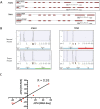Transcriptome-wide analysis of alternative RNA splicing events in Epstein-Barr virus-associated gastric carcinomas
- PMID: 28493890
- PMCID: PMC5426614
- DOI: 10.1371/journal.pone.0176880
Transcriptome-wide analysis of alternative RNA splicing events in Epstein-Barr virus-associated gastric carcinomas
Abstract
Multiple human diseases including cancer have been associated with a dysregulation in RNA splicing patterns. In the current study, modifications to the global RNA splicing landscape of cellular genes were investigated in the context of Epstein-Barr virus-associated gastric cancer. Global alterations to the RNA splicing landscape of cellular genes was examined in a large-scale screen from 295 primary gastric adenocarcinomas using high-throughput RNA sequencing data. RT-PCR analysis, mass spectrometry, and co-immunoprecipitation studies were also used to experimentally validate and investigate the differential alternative splicing (AS) events that were observed through RNA-seq studies. Our study identifies alterations in the AS patterns of approximately 900 genes such as tumor suppressor genes, transcription factors, splicing factors, and kinases. These findings allowed the identification of unique gene signatures for which AS is misregulated in both Epstein-Barr virus-associated gastric cancer and EBV-negative gastric cancer. Moreover, we show that the expression of Epstein-Barr nuclear antigen 1 (EBNA1) leads to modifications in the AS profile of cellular genes and that the EBNA1 protein interacts with cellular splicing factors. These findings provide insights into the molecular differences between various types of gastric cancer and suggest a role for the EBNA1 protein in the dysregulation of cellular AS.
Conflict of interest statement
Figures







Similar articles
-
The Epstein-Barr virus EBNA1 protein modulates the alternative splicing of cellular genes.Virol J. 2019 Mar 4;16(1):29. doi: 10.1186/s12985-019-1137-5. Virol J. 2019. PMID: 30832682 Free PMC article.
-
Epstein-Barr virus-positive gastric cancer involves enhancer activation through activating transcription factor 3.Cancer Sci. 2020 May;111(5):1818-1828. doi: 10.1111/cas.14370. Epub 2020 Mar 20. Cancer Sci. 2020. PMID: 32119176 Free PMC article.
-
Olaparib-induced Apoptosis Through EBNA1-ATR-p38 MAPK Signaling Pathway in Epstein-Barr Virus-positive Gastric Cancer Cells.Anticancer Res. 2022 Jan;42(1):555-563. doi: 10.21873/anticanres.15513. Anticancer Res. 2022. PMID: 34969765
-
Epstein-Barr virus and gastric carcinoma.Pathol Int. 2010 May;60(5):337-50. doi: 10.1111/j.1440-1827.2010.02533.x. Pathol Int. 2010. PMID: 20518883 Review.
-
Potential cellular functions of Epstein-Barr Nuclear Antigen 1 (EBNA1) of Epstein-Barr Virus.Viruses. 2013 Jan 16;5(1):226-40. doi: 10.3390/v5010226. Viruses. 2013. PMID: 23325328 Free PMC article. Review.
Cited by
-
Polyadenylate-binding protein cytoplasmic 1 mediates alternative splicing events of immune-related genes in gastric cancer cells.Exp Biol Med (Maywood). 2022 Nov;247(21):1907-1916. doi: 10.1177/15353702221121631. Epub 2022 Sep 12. Exp Biol Med (Maywood). 2022. PMID: 36112850 Free PMC article.
-
The Epstein-Barr virus EBNA1 protein modulates the alternative splicing of cellular genes.Virol J. 2019 Mar 4;16(1):29. doi: 10.1186/s12985-019-1137-5. Virol J. 2019. PMID: 30832682 Free PMC article.
-
Prognostic significance of survival-associated alternative splicing events in gastric cancer.Aging (Albany NY). 2020 Nov 7;12(21):21923-21941. doi: 10.18632/aging.104013. Epub 2020 Nov 7. Aging (Albany NY). 2020. PMID: 33186122 Free PMC article.
-
Integrative bioinformatics analysis of prognostic alternative splicing signatures in gastric cancer.J Gastrointest Oncol. 2020 Aug;11(4):685-694. doi: 10.21037/jgo-20-117. J Gastrointest Oncol. 2020. PMID: 32953152 Free PMC article.
-
Identification of Novel Alternative Splicing Events Associated With Tumorigenesis, Protein Modification, and Immune Microenvironment in Early-Onset Gastric Cancer.Front Oncol. 2021 Jun 8;11:640272. doi: 10.3389/fonc.2021.640272. eCollection 2021. Front Oncol. 2021. PMID: 34168979 Free PMC article.
References
-
- Dicken BJ, Bigam DL, Cass C, Mackey JR, Joy AA, Hamilton SM. Gastric adenocarcinoma: review and considerations for future directions. Ann Surg. 2005;241:27–39 doi: 10.1097/01.sla.0000149300.28588.23 - DOI - PMC - PubMed
-
- Sturgeon CM, Diamandis E. Tumor Markers in Gastric Cancer. In Use of Tumor Markers in Liver, Bladder, Cervical, and Gastric Cancers. American Association for Clinical Chemistry. 2010. - PubMed
-
- Shinozaki-Ushiku A, Kunita A, Fukayama M. Update on Epstein-Barr virus and gastric cancer (Review). Int J Oncol. 2015;46:1421–1434. doi: 10.3892/ijo.2015.2856 - DOI - PubMed
MeSH terms
Substances
LinkOut - more resources
Full Text Sources
Other Literature Sources
Medical
Molecular Biology Databases
Research Materials

